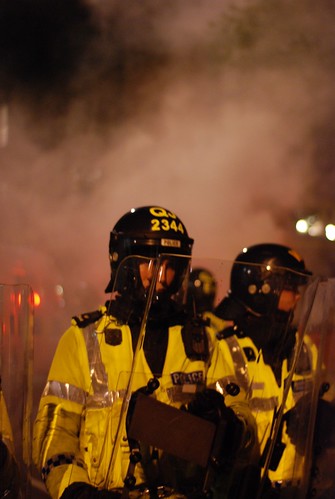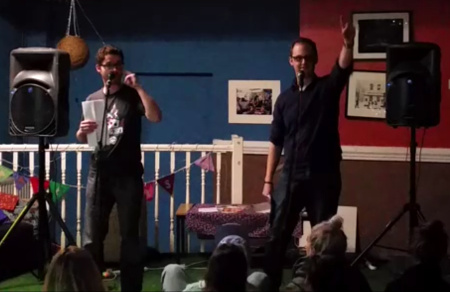Reporting a riot in Britain: how the police spun the battle of Stokes Croft
Article published: Sunday, April 24th 2011
When rioting broke out in the Stokes Croft area of Bristol in the early hours of Friday morning, swathes of people across the country found themselves glued to Twitter, following the action as it unfolded.

Riot police in Stokes Croft. Photo: Stringberd
The unrest began when Avon and Somerset police descended on a squatted property at Cheltenham Road late on Thursday evening, in an attempt to arrest squatters who they claimed had “criminal intentions”.
The squat, known as Telepathic Heights, is located opposite a Tesco Express store, which recently opened despite strong resistance and campaigning from local people who felt it would pose a threat to local businesses. Police said they had received intelligence that the squatters were making petrol bombs, and obtained a warrant to search the property on that basis. “There was a very real threat to the local community,” said Assistant Chief Constable Rod Hansen.
After four arrests were made, protesters gathered in the streets. Police told the crowds to disperse, but were ignored. There was a confrontation, the Tesco was attacked and objects were thrown at police. What happened next has been documented in detail by Oli Conner in his first-hand account, published yesterday on ourKingdom. Bristol resident Adam Ramsay has also provided a useful eye-witness report here, which includes some of the background story.
The mainstream media were extremely slow to respond to the chaotic scenes. Twitter was ablaze with people shocked at the lack of coverage. “Searching for info on #StokesCroft uprising in the absence of proper media coverage is like living in fucking China or North Korea,” tweeted @meowist_gorilla.
Others speculated it was a conspiracy to suppress details of the riot getting out. “Looks to me like the media has been ordered not to run the #StokesCroft riot story,” wrote @SDMumford. “Sounds to me completely botched by the police.”
A more likely and less sinister reason for the absence of instant coverage, though, was the timing. The event occurred in the early hours on a public holiday . . . most of Bristol’s small congregation of working hacks were probably in bed or somewhere far from the newsroom. (If it had occurred in London, there is little doubt that the story would have been given more immediate attention – for no other reason than that there are a far greater number of journalists living and working in the capital, particularly at night time.)
Nonetheless, when the story eventually did break, there can be no excuse for the poor standard of the reporting. Most of the major national news outlets – the Daily Telegraph, the Daily Mail, the Independent, the Express, the Guardian, the Sun, the BBC and the Times – ran with a “police hurt by protesters” headline, yet most of the photographs and videos available on the internet depicted injured protesters.
According to a scan performed by churnalism.com (a Media Standards Trust website that can compare a press release with articles published by national newspapers), the Telegraph had simply copied and pasted 74% of its report from a police news release. The Express wasn’t much better, at 71%; and the BBC, too, were also guilty of a cut and paste job – their report, which was later amended, copied 68% of the police line.
Of more concern was the striking lack of accuracy. Despite no eyewitness accounts to corroborate it, almost all of the major newspapers published a bogus assertion that the Tesco opposite the squat was “petrol bombed”. The alleged incident, which seems to have originated in a report by the Press Association, formed the basis of several newspapers’ headlines.
“Riot police bombarded and shop petrol-bombed,” stated the Daily Mail; “Tesco store petrol bombed,” recounted the Telegraph; “PETROL BOMBS FLY IN BRISTOL TESCO RIOT HELL,” howled the Star. Even the respectable Times was guilty: “mob petrol bombs Tesco,” they wrote, before later amending their piece to read instead, “Bristol mob wrecks Tesco store and attacks police”.
In the first instance, it was pure anti-journalism: uncorroborated rumours presented as fact, with the police’s account of events regurgitated scarcely without question or counter. (It should also be noted that two of the better reports came from the Guardian and, unusually, the Sun – both of whom gave claims of police heavy handedness moderately fair prominence.)
Even at the time of writing – 24 hours after the riot – the “petrol bombs thrown at Tesco” line still stands on the websites of several of the above listed newspapers. It has not been corrected, substantiated, verified or cross referenced. But it is still being presented to the world as if it is fact – and for all those who are not in the know, it will be treated as such.
This is a problem, of course, not least because journalism that is inaccurate is journalism that is worthless. There is already a sense of disdain and distrust for the mainstream media among many protesters and activist groups – and unfortunately the subpar reporting of the Stokes Croft riot illustrates precisely why.
As we have witnessed throughout several recent large protests involving students and cuts demonstrators, there has all too often been a high prevalence of regurgitated police press releases, paired with obvious bias in favour of the authorities no matter what the circumstances. Inaccurate reporting is, on this occasion, the final nail in the coffin.
Consequently, more and more people, particularly those involved in various protest movements, are now shunning the mainstream press altogether. This can result – as Dan Hancox argues in his introduction to OurKingdom’s Reader on the Winter Protests, Fight Back! – in a form of “self kettling”, a kind of self-imposed isolation. Increasingly, information is shared and disseminated on a peer-to-peer basis via social networks (live video streams are also a growing phenomenon, and on Friday morning on-the-ground live footage from @grantikins was watched by thousands). Where the mainstream media has fallen short, it seems, citizen journalists have stepped in.
Many, particularly the young, now appear to feel that the only way to obtain the factual truth is from those ‘live tweeting’ at the scene. For honest, traditional journalists (and there are still a few), this is a sad and problematic state of affairs. But who can blame people for their media disillusionment? They have been failed by bad journalism and with nowhere else to go have turned to each other for a better alternative.
On Twitter, as the scenes on the streets of Stokes Croft reached a conclusion at around 4am on Friday, the feeling was summed up by @BrumProtestor in no uncertain terms. “Twitter has been great tonight, thanks to all #StokesCroft people tweeting,” he wrote. “Fuck you mainstream media, we don’t need you anymore.”
Ryan Gallagher is a freelance journalist based in London.
This article first appeared on openDemocracy.net. The original can be found here.
More: Blog
Comments
-
Great stuff. I was actually working for the Press Association when this story went out. I had to call some friends in Bristol to try to get some accurate reports. Everyone was denying the petrol bomb element but the news editor said to keep it in. It was only because I made the effort to get stories from the other side that there was anything critical inculded all.
Comment by Patrick on April 27, 2011 at 7:37 pm
The comments are closed.



